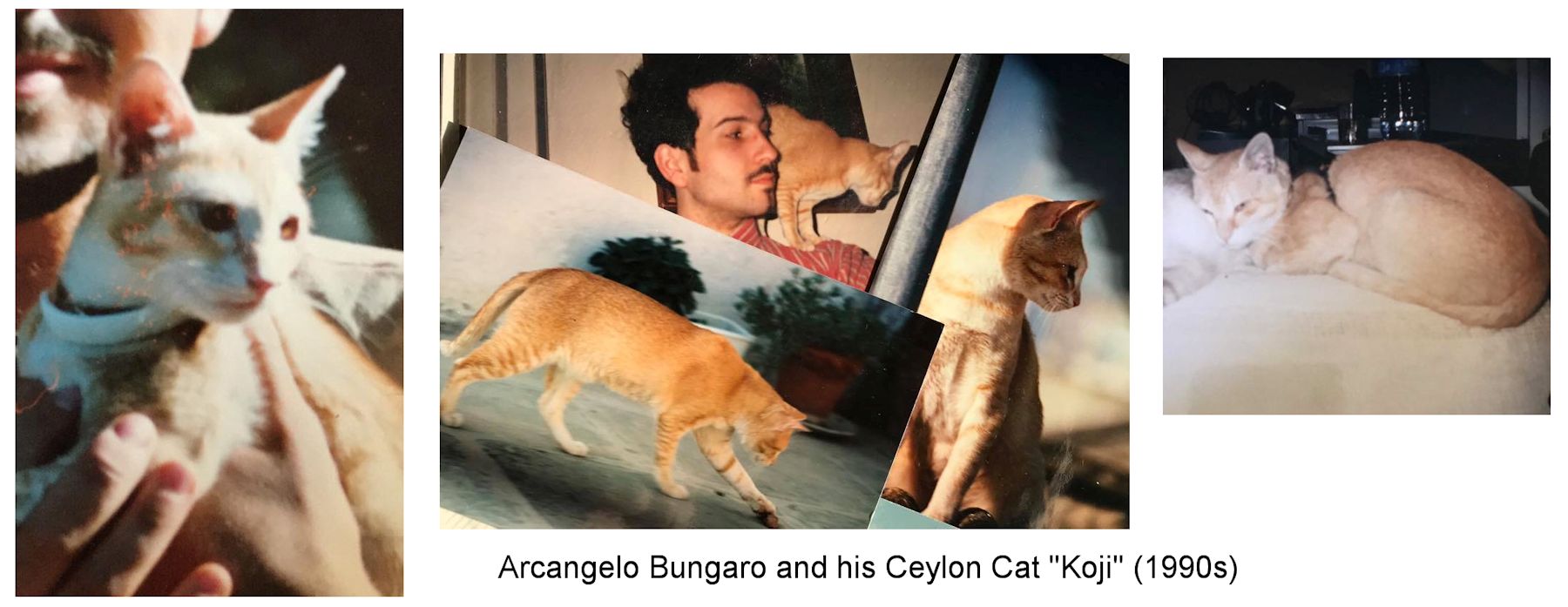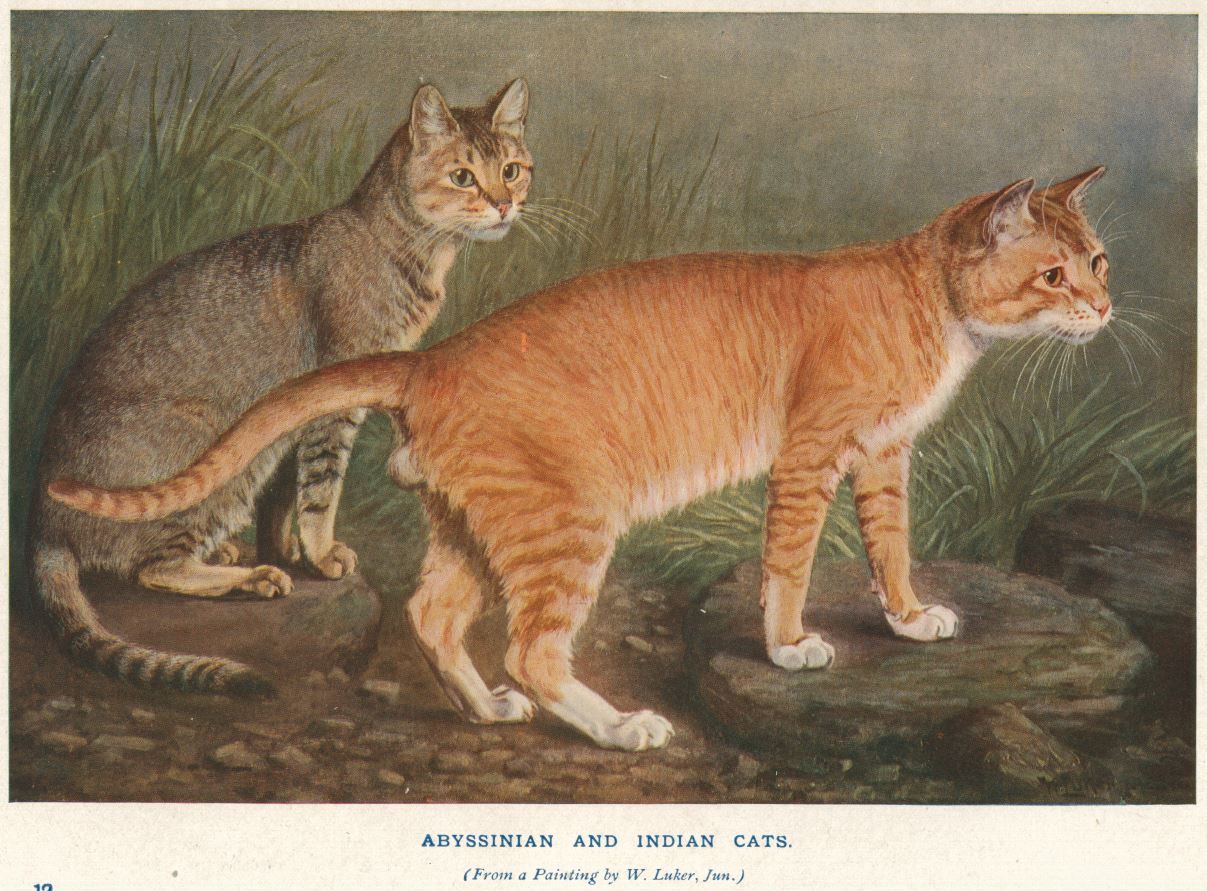
LOST BREEDS – THE CEYLON CAT (CELONESE)
This natural breed was discovered in 1984 and gained recognition as an experimental breed in 1988, but was almost unknown outside of Italy. It is so rare that I have grouped it among the lost breeds, although it would be possible to restore the breed using new imports from its homeland. In 2017, Arcangelo Bungaro (who owned the Ceylon Cat “Koji” whose pictures appear in this article) thought it was no longer bred, although it is still listed on some Italian cat fancier sites.

DISCOVERY OF THE CEYLON CAT
The Ceylon Cat (sometimes called Celonese in English) is a ticked tabby domestic cat native to the island of Sri Lanka where it is endemic and has remained purebred due to its isolation from the mainland. Its ancestry is said to includes Felis chaus kelaarti (Felis chaus affinis), a jungle cat subspecies, but this would need to be confirmed through DNA testing. Since 2017, F. c. affinis includes cats previously classified as Felis kutas (Bengal, India), Felis chaus kelaarti (Southern India and Sri Lanka), Felis chaus prateri (North West India and South West Pakistan) and Felis chaus affinis (Northern India and the Himalayas). F. chaus blood or not, ticked tabbies are endemic to the region and in the early days of the cat fancy, HC Brooke described a sandy coloured ticked cat that he called the “Indian Cat” to differentiate it from the Abyssinian.

The Ceylon Cat developed naturally on the island of Sri Lanka without artificial selection. Isolation allowed its appearance and temperament to become fixed. The exhibition Celonese also breeds true for these characteristics so that it remains similar to its ancestors in Sri Lanka. The Italian Dottore Paolo Pellegatta, a doctor of veterinary medicine from Verigiate Corgeno, (near Milan, Italy) brought this pretty natural breed to the attention of the cat fancy after a trip to Ceylon in January 1984. He was on an extended trip to the Orient and decided to stop in Sri Lanka and go off the much-travelled tourist path and visit some other parts. He frequently encountered little free-roaming cats and though semi-feral, they greeted him for a fuss and a snack of coconut.
Pellegatta was fascinated by the native breed and decided to take some back to Italy. Dr Mehemaduna of the Colombo Zoo helped with the exportation process and documents and Swiss Air transported the cats. The first four imports were two males, Tisa and Serendib, and two females, Taranga and Aralyia. The Ceylon Cats adapted quite well to the radical change in climate, but to help with the transition from Sri Lanka to Italy, Dr Pellegatta had woollen sweaters made for each one and the cats soon discovered the steam radiators in is home where they sat watching the unfamiliar snow outside the windows. The Ceylon Cats were exhibited at a cat show in Erba and were featured on Italian TV and in newspapers.
BREED DEVELOPMENT
Pellegatta’s imports formed the basis of a breeding programme and were augmented by additional cats imported from Sri Lanka in order to widen the gene pool and prevent the need for outcrossing to non-Celonese cats. In 1984, the Ceylon Cat Lovers Club (Club Amatori del Gatto di Ceylon) was founded within FIFe and the first breed standard was drawn up in 1988.
The Ceylon cat was presented to the FIFe officials during the annual meeting at Como, Italy in May 1988. The response was overwhelmingly positive and the president of the FIFe Judges Commission, Stephe Bruin, asked Dr Pellegatta to formally present the Ceylon Cat to the FIFe Judges Commission for acceptance as an experimental breed. At The Milan Cat Show in October, 1988 the commission found sufficient distinguishing characteristics and uniformity among the cats presented were found to merit acceptance. Progression to full breed recognition was slowed down in part by the rigid requirements of FIFe and also Dr Pellegatta’s conscientious breeding to ensure that any undesirable genetic defects were removed from the bloodlines. In any natural breed there are a few "defects."

The main purpose of the breed club was to safeguard the original genetic heritage of these cats under the name “Ceylon Cat” (or Celonese), the British name for Sri Lanka in colonial times. Hence all Ceylon Cats registered in Europe must be direct descendants of indigenous Ceylon Cats from Sri Lanka without any outcrossing to other breeds or varieties. As one of the very few natural breeds developed without human intervention or selection it is important to retain pure bloodlines. By 1992 it was written that the Ceylon Cat was enjoying a discreet success among cat judges, breeders and cat fans alike, however it was almost unknown outside of Italy apart from an article in a British cat magazine and one in a German cat magazine.
Whenever a breed standard is created it can cause deviation from the original type because breeders may exaggerate desirable traits (as in the Persian with its “short muzzle”). To counter this trend and prevent inbreeding, the Ceylon Cat Lovers Club recommended introducing new imports of native Sri Lanka cats every 4 or 5 generations. This would maintain the correct appearance of the exhibition Ceylon Cat so that it remained close to the original foundation cats. Cats imported from Sri Lanka would require a Certificate of Origin and Authenticity, approved and recognized by the Club. This can be problematical because western cat breeds taken to Sri Lanka as pets threaten the purity and appearance of the native breed, more so in towns than in rural areas.
DESCRIPTION AND BREED STANDARD
The Ceylon Cat is an elegant, agile and graceful cat. It is medium sized and looks slender, but is actually quite compact and muscular with harmonious proportions. There is obvious sexual dimorphism, the males being larger than the females, but both sexes have a refined, but not thin, bone structure and are well- muscled and graceful.
It is bred in ticked tabby in all natural colours. White spots or “pointed” colours are prohibited as these do not occur in the natural breed. The classic colour is a black-ticked golden colour, known as "manila" (the colour of a type of envelope). The ticking is uniform and covers the entire back, with well-defined stripes on the limbs, rings on the tail, and small spots on the abdomen. Like all tabby cats there is an M-shaped marking on the forehead; this is slightly modified in the Ceylon Cat and is known as a "cobra" marking. This marking is considered lucky in Sri Lanka where the cobra is associated with the Buddhist tradition. The eyelids have black borders and a border of lighter colour hair surrounding them. The ears point slightly forward. Lynx tips (but not excessive) and pale thumb prints behind the ears are desirable.

All natural colours (i.e. not introduced from Western or Siamese/Burmese cats) are accepted. Brown (i.e. Black) Ticked Tabby is the most common and typical colour. Known as “manilla” in FIFe, it is called “alu pata” (ash colour) in Sri Lanka. Black is called manilla, then blue, red, cream and their respective tortie colours are permitted. White spotting and non-agouti (solid colour) are not allowed, nor are silver, colourpoint, chocolate, lilac etc as these do not occur in the natural cat population of Sri Lanka. The tabby colours vary from black, to honey blonde, to cinnamon, ginger, and even to the warm orange pekoe (the colour of Ceylon tea). Three patterns are recognized and all can occur in a single litter:
Bentota ((BEN) domestic-type ticked tabby) was the first pattern observed by Dr. Pellegatta at the village of Bentota in Sri Lanka. The entire back is covered with uniform ticking and there are well-defined stripes on the limbs. There are small spots on the abdomen has small spots and the tail has ringed markings. There is the "cobra" marking on the forehead; this pattern is prized in its native land.
Chaus ((CHAUS) wild-type ticked tabby) is where the coat pattern resembles the Indian form of Felis chaus. The whole body is uniformly ticked with some small stripes decorate the limbs.
Continental or Tabby (CON) is where the mackerel tabby pattern covers the whole body. This pattern is also endemic in cats throughout Asia.
The Ceylon cat is sweet and affectionate, and is friendly with family members and with strangers. Its non-aggressive docile nature makes it suitable for families with children. Although it can live in an apartment it is playful and energetic and ideally needs access to an outside area where it can burn off its energy. The coat needs very little care apart from just combing with a fine-tooth comb and occasional slicking with a damp cloth.The females are precocious and begin to call at six months, but it is better to wait until they are 12 months old and fully developed physically. They are usually excellent mothers.
FIFe Standard of the Ceylon Cat
BODY: The Ceylon Cat is small to medium sized, with a fine bone structure; rather short and deep body with well-rounded abdomen; fairly broad chest. Compact and well-muscled. Strong, short muscular neck.
LEGS: The legs are fine boned and not too long; well-muscled; the hind legs are slightly longer than the front.
FEET: The feet are small and round, with paw pads in keeping with basic colour.
HEAD: The head is medium sized, in proportion to the body, with rounded cheeks and prominent cheek bones. Slight whisker break. Rather short nose with a slight break at eye level. Forehead and top of head slightly flattened. Chin well developed but not too pronounced. Nose leather pink, rim in keeping with basic colour. Ears are large, open at the base, set high on the head and have rounded tips. The eyes are rather large, top line almond shaped, bottom line rounded. They are set well apart. Colour: from lustrous yellow to green. The Ceylon Cat has a characteristic dreamy expression.
TAIL: The tail is fairly short, wide at the base and tapers to a rounded point.
COAT: The coat is short, fine and silky, close lying with little undercoat. Body and sides show a uniform, pronounced ticking; underparts gradually shading off to a paler tone with clearly marked spots on the belly. One to three unbroken necklaces. A characteristic “Cobra” design on the forehead and two or three stripes on the cheeks. Clearly defined stripes on the legs. Tail ringed, the tip being solid and in keeping with the basic colour.
COLOUR: Ground colour in various hues from sandy to golden. Ticking and markings in black on the sandy to golden range is known as Manila. Black markings also appear on the blue, red, cream or the appropriate tortoiseshell.
FAULTS: long slender body; wide set ears; dominant, round eyes; tendency to spotting on back and flanks; absence of spots on belly.
FAULTS THAT EXCLUDE A CERTIFICATE (when recognised for competition): white patches, except on the chin; lack of either stripes on legs or rings on the tail
SCORING
HEAD (General Shape) - 15 points
EARS - 10 points
EYES (Shape and expression) - 10 points
BODY (General shape) - 25 points
TEXTURE OF COAT - 10 points
PATTERN AND TICKING - 25 points
CONDITION - 5 points
TOTAL -100 points